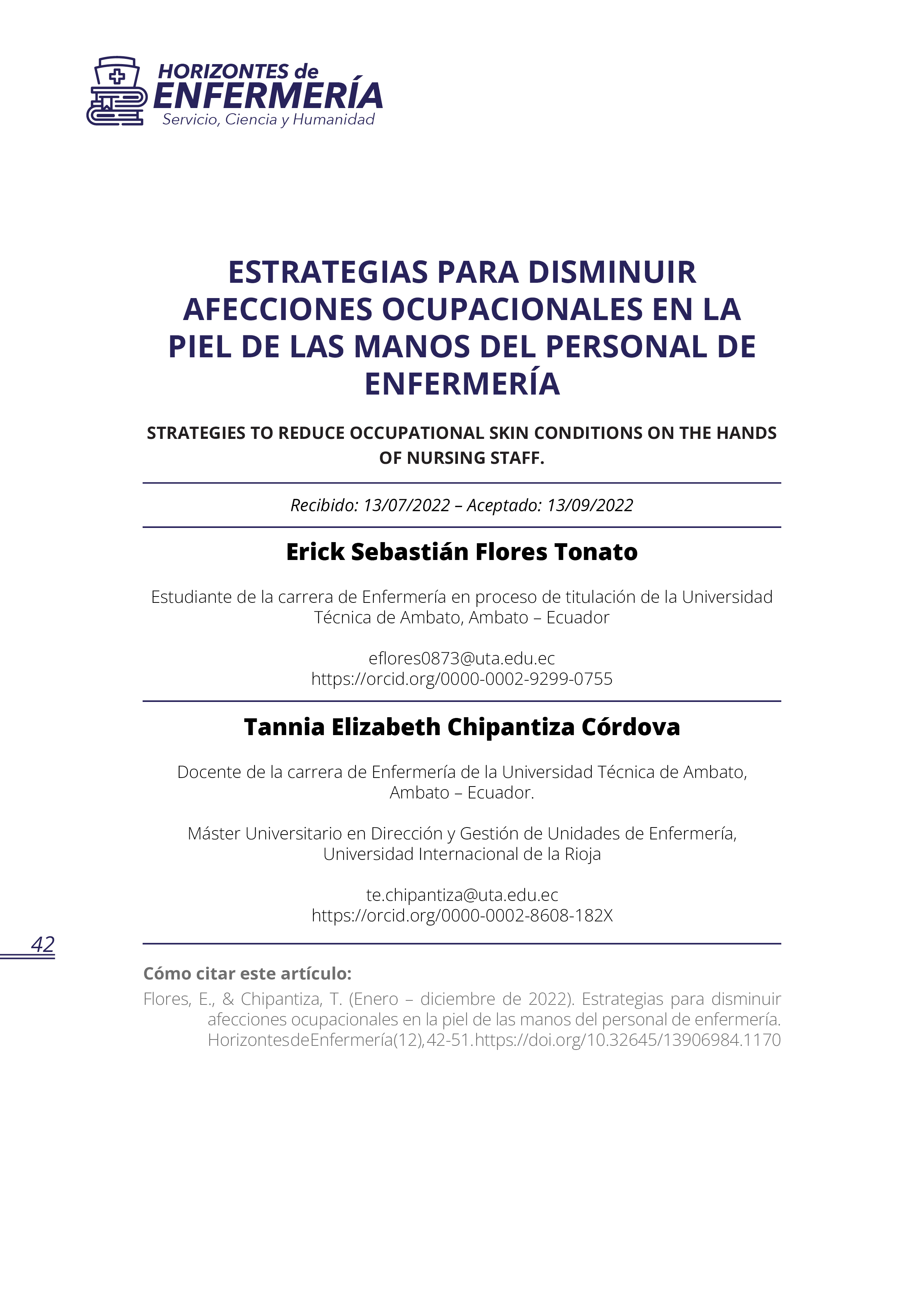Strategies to reduce occupational skin conditions on the hands of nursing staff.
DOI:
https://doi.org/10.32645/13906984.1170Keywords:
Hand eczema , Hand washing, NursingAbstract
The skin conditions of the hands are among the most significant problems faced by the nursing staff due to their continuous exposure to triggering factors, thus affecting the quality of the care process. The objective of this research was to promote strategies that reduce occupational skin conditions in the hands of nursing staff. A quantitative, observational, descriptive, non-experimental study was carried out based on data collection through a validated instrument and reviewed by experts in health and scientific research and the application of statistical processes. The population was constituted of 80 nursing professionals belonging to public and private health establishments in the city of Ambato. The results obtained were that 100% have had skin conditions on their hands where the most affected were within the range of 11 to 15 years of professional life. The prevalent risk factors were: exposure to humidity, use of antiseptic solutions, and hand washing more than 16 times (63.7%) during the working day. 70% reported not having an allergy to latex, and 30%
only when their use was prolonged. The main signs and symptoms were erythema, itching, and burning. It was evident that within the health establishments, there are no prevention strategies for these conditions, which is why the creation and implementation were unanimously supported, thus determining the importance of this research.
References
Arroyo-Cruz, M. E., Collado-Chagoya, R., Hernández-Romero, J., Alvarado-Gumaro, A., García-González, A., Campos-Gutiérrez, R., . . . Velázquez-Sámano, G. (2018). Sensibilización y alergia a látex en residentes quirúrgicos del Hospital General de México. Revista alergia México, 65(2), 128-139. http://www.scielo.org.mx/scielo.php?script=sci_arttext&pid=S2448-91902018000200128&lng=es
Bazualdo Fiorini, E., Rodríguez Rincón, J., Pilatasig Pérez, L., & Tacle Humanante, S. (2022). Dermatitis de contacto ocupacional en trabajadores de salud durante pandemia por COVID-19. RECIMUNDI, 6(2), 73-82. https://www.recimundo.com/index.php/es/article/view/1543
Briceño-Ayala, L. (2022). Medicina preventiva, ocupacional y ambiental. Bogota: El Manual Moderno S.A. https://books.google.com.ec/books?hl=es&lr=&id=P9NyEAAAQBAJ&oi=fnd&pg=PT387&dq=dermatitis+profesionales+de+salud+&ots=yluF_OKH8q&sig=QCY43ZLFrftc5JwM1naicbNwWaw#v=onepage&q&f=false
Chaparro Aguilera, N., & Rodriguez Serna, M. (2019). ¿Qué es la dermatitis de contacto? Diagnóstico y alérgenos más comunes. Enfermería integral (122), 69-73. https://www.enfervalencia.org/ei/122/ENF-INTEG-122.pdf
Fundacion BBVA. (2021). El libro de las enfermedades dermatologicas.Ergon Creación, S. A.
García Albán, G., & J, H. L. (2021). Afecciones ocupacionales de la piel de las manos, presentes en el personal de enfermería del área de neonatología. Enfermeria Dermatologica, 15(44). https://enfermeriadermatologica.org/index.php/anedidic/article/view/106
García de Acevedo, C., Adame, M., Aguilar, M., Arias, G., Carbajosa, J., & Miranda, G. (2021). Manifestaciones cutáneas secundarias a la pandemia de COVID-19. Acta Med Grupo Angeles, 19(1), 27-36. https://www.medigraphic.com/pdfs/actmed/am-2021/ams211e.pdf
Gheisari, M., Araghi, F., Moravvej, H., Tabary, M., & Dadkhahfar, S. (2020). Skin reactions to non-glove personal protective equipment: an emerging issue in the COVID-19 pandemic. J Eur Acad Dermatol Venereol, 34(7), 297-298. https://onlinelibrary.wiley.com/doi/10.1111/jdv.16492
Gil-Castaño, G., & Cardona, R. (2021). Emolientes: beneficios, elementos clave y aplicación clínica. Revista alergia México, 67(2), 128-141. http://www.scielo.org.mx/scielo.php?script=sci_arttext&pid=S2448-91902020000200128&lng=es
Guertler, A., Moellhoff, N., Schenck, T. L., Hagen, C. S., Kendziora, B., Giunta, R. E., . . . Reinholz, M. (2020). Onset of occupational hand eczema among healthcare workers during the SARS-CoV-2 pandemic: Comparing a single surgical site with a COVID-19 intensive care unit. Contact Dermatitis, 83(2), 108 - 114. https://onlinelibrary.wiley.com/doi/full/10.1111/cod.13618
Hamnerius, N., Svedman, C., Bergendorff, O., Björk, J., Bruze, M., & Pontén, A. (2017). Wet work exposure and hand eczema among healthcare workers: a cross-sectional study. British Journal of Dermatology, 178(2), 452-461. https://onlinelibrary.wiley.com/doi/10.1111/bjd.15813
Kersh, A., Johansen, M., Ojeaga, A., & de la Feld, S. (2021). Hand Dermatitis in the Time of COVID-19: A Review of Occupational Irritant Contact Dermatitis. PubMed, 32(2), 86-93. doi:10.1097/DER.0000000000000721
M.-B. Cleenewerck, M.-N. C. (2022). Dermatosis profesionales: diagnóstico, prevención y compensación,. ScienceDirect, 56(1), 1 - 10. https://www.sciencedirect.com/science/article/pii/S1761289622460572
Melo, M., Villarinho, A., & Leite, I. (2019). Sociodemographic and clinical profile of patients with occupational contact dermatitis seen at a work-related dermatology service,2000 - 2014. Anais brasileiros de dermatologia, II(94), 147-156. https://www.ncbi.nlm.nih.gov/pmc/articles/PMC6486076/#r2,%2010.1590/abd1806-4841.20197235
Monica Shah, M. S., Afsaneh Alavi, V., & Shi, J. (2020). Optimizing care for atopic dermatitis patients during the COVID-19 pandemic. ScienceDirect, 83(2), 165-167.
ORGANIZACION MUNDIAL DE SALUD. (Abril de 2020). Recommendation to Member States to improve hand hygiene practices widely to help prevent.
Paniagua, M., Cabrera, S., & Rodríguez, C. (2021). Factores de riesgo en dermatitis por contacto en usuarios de la consulta dermatologica del Hospital General Plaza de la Salud periodo Abril-Julio 2021. Morona Santiago: Universidad Nacional Pedro Henríquez Ureña. https://repositorio.unphu.edu.do/bitstream/handle/123456789/4390/Factores%20de%20riesgo%20en%20dermatitis%20por%20contacto%20en-%20Maricarmen%20Paniagua%20De%20Pe%c3%b1a%20.pdf?sequence=1&isAllowed=y
Pourani, M., Ganji, R., Dashti, T., Dadkhahfar, S., Gheisari, M., Abdollahimajd, F., & Dadras, M. S. (2022). [Artículo traducido] Impacto de la pandemia de COVID-19 en los pacientes con dermatitis atópicaImpact of COVID-19 Pandemic on Patients with Atopic Dermatitis. sciencedirect, 113(3), 286-293. https://www.sciencedirect.com/science/article/pii/S0001731021003264
Redondo, G., E, & E, I. P. (2020). Dermatitis ocupacional en manos: cuidados y recomendaciones para profesionales sanitarios. Enfermreria dermatologica, 14(40). https://enfermeriadermatologica.org/index.php/anedidic/article/view/74
Rios Rios, K. R., & Rodriguez Alonso, D. H. (2021 ). Dermatitis de contacto ocupacional: Revisión sistemática. Escuela Académica Profesional de Medicina. https://repositorio.ucv.edu.pe/bitstream/handle/20.500.12692/66085/Rios_RKR-SD.pdf?sequence=1&isAllowed=y
Rosales Gaspar, G., Paucar Quispe, A., & Bonilla Asalde, M. (2018). Efectividad del uso de cremas hidratantes en la prevencion de la dermatitis ocupacional en el personal de salud. Lima: Universidad Privada Norbert Wiener. http://repositorio.uwiener.edu.pe/bitstream/handle/123456789/2106/ESPECIALIDAD%20-%20Ada%20Raquel%20Paucar%20Quispe.pdf?sequence=1&isAllowed=y
Sierra Salas, P. A., Rubiano Amezquita, C. M., & Murcia Coca, J. L. (2022). Prevalencia de Dermatitis de Contacto Alérgica e Irritativa en trabajadores de diversos sectores económicos que consultaron a una IPS de salud ocupacional en Bogotá, Colombia, 2021. Universidad del rosario. https://repository.urosario.edu.co/handle/10336/33405
Silvestre Salvador, J., Heras Mendaza, F., Hervella Garcés, M., Palacios-Martínez, D., Sánchez Camacho, R., Senan Sanz, R., & Apellaniz González, A. (2020). Guidelines for the Diagnosis, Treatment, and Prevention of Hand Eczema. ScienceDirect, 111(1), 26-40. https://www.sciencedirect.com/science/article/pii/S1578219019303737

Downloads
Published
Issue
Section
License
Copyright (c) 2022 Erick Sebastián Flores Tonato, Tannia Elizabeth Chipantiza Córdova

This work is licensed under a Creative Commons Attribution-NonCommercial-ShareAlike 4.0 International License.
El autor mantiene los derechos morales e intelectuales de su obra, autorizando a la editoruial de la revista revista Horizontes de Enfermería ladifusión y la divulgación de su contenido con fines estrictamente académicos y de investigación, sin fines de lucro.




